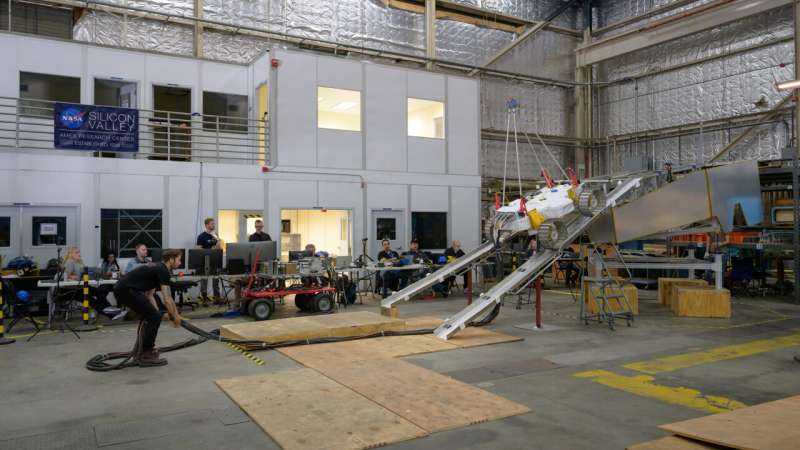NASA's moon rover prototype conquers steep, scary lander exit test
Wednesday, 05 July 2023 19:08
NASA's VIPER—short for Volatiles Investigating Polar Exploration Rover—recently completed another successful round of rigorous tests of the agency's first robotic moon rover's ability to drive off the Astrobotic Griffin lunar lander and onto the lunar surface. Called an egress, this hours-long operation is one of the most critical and trickiest parts of VIPER's 100-day mission. It could be even trickier if VIPER's off-ramps onto the moon are super steep or tilted due to uneven terrain.
Rivada gets more breathing room to deploy constellation
Wednesday, 05 July 2023 14:11
International regulators have waived a requirement for Rivada Space Networks to launch 10% of its proposed 576 satellites by September, boosting plans to fund the multibillion-dollar connectivity constellation.
Astrotourism—chasing eclipses, meteor showers and elusive dark skies from Earth
Wednesday, 05 July 2023 14:00
For years, small groups of astronomy enthusiasts have traveled the globe chasing the rare solar eclipse. They have embarked on cruises to the middle of the ocean, taken flights into the eclipse's path and even traveled to Antarctica. In August 2017, millions across the U.S. witnessed a total solar eclipse visible from Oregon to South Carolina, with a partial eclipse visible to the rest of the continental U.S.
The interest in astronomical events that this eclipse sparked will likely return with two eclipses visible in the U.S. during the next year—the annular solar eclipse on Oct. 14, 2023, and the total eclipse on April 8, 2024. But astro-tourism—traveling to national parks, observatories or other natural, dark-sky locations to view astronomical events—isn't limited just to chasing eclipses.
According to a recent study, 80% of Americans and one-third of the planet's population can no longer see the Milky Way from their homes because of light pollution.
Radio noise from satellite constellations could interfere with astronomers
Wednesday, 05 July 2023 10:45
Large satellite constellations can unintentionally generate electromagnetic noise, creating an additional source of interference for radio astronomers.
Time to act on light pollution, say leading experts at NAM conference
Wednesday, 05 July 2023 09:27 Action on light pollution is long overdue, campaigners will say at a panel event (3 July) at the National Astronomy Meeting in Cardiff. The panellists call for UK governments and local authorities to put policies in place to restore our view of the skies and to mitigate the impacts of excessive light at night on biodiversity and potentially human health.
Light pollution is rarely far from
Action on light pollution is long overdue, campaigners will say at a panel event (3 July) at the National Astronomy Meeting in Cardiff. The panellists call for UK governments and local authorities to put policies in place to restore our view of the skies and to mitigate the impacts of excessive light at night on biodiversity and potentially human health.
Light pollution is rarely far from iRocket contracts with US Space Force to transform how launch vehicles are powered
Wednesday, 05 July 2023 09:27 Innovative Rocket Technologies Inc. (iRocket), a company that provides low cost and rapid access to space with its 100% reusable rockets, announced that it signed a contract with the U.S. Space Force Space Systems Command (SSC). Under the contract, iRocket will further develop its highly reusable rocket engine, which will transform how launch vehicles are powered with clean, sustainable propella
Innovative Rocket Technologies Inc. (iRocket), a company that provides low cost and rapid access to space with its 100% reusable rockets, announced that it signed a contract with the U.S. Space Force Space Systems Command (SSC). Under the contract, iRocket will further develop its highly reusable rocket engine, which will transform how launch vehicles are powered with clean, sustainable propella Time appears five times slower in early universe: study
Wednesday, 05 July 2023 09:27 Time appears to run five times slower in the early universe, scientists said on Monday, for the first time using extraordinarily bright cosmic objects called quasars as "clocks" to confirm this strange phenomenon.
Einstein's theory of relativity predicts that because space is expanding, "we should see the distant universe run in slow motion," said Geraint Lewis, an astrophysicist at the Univ
Time appears to run five times slower in the early universe, scientists said on Monday, for the first time using extraordinarily bright cosmic objects called quasars as "clocks" to confirm this strange phenomenon.
Einstein's theory of relativity predicts that because space is expanding, "we should see the distant universe run in slow motion," said Geraint Lewis, an astrophysicist at the Univ Hawaii observatories play criical role adding color to new space mission
Wednesday, 05 July 2023 09:27 Observing billions of galaxies across more than a third of the sky and building a 3D map of the universe are all part of the Euclid mission that the European Space Agency launched with its Euclid satellite from Cape Canaveral, Florida. Euclid's dataset is getting a big helping hand from observations taken at three observatories in Hawaii.
The Euclid satellite mission will spend more than s
Observing billions of galaxies across more than a third of the sky and building a 3D map of the universe are all part of the Euclid mission that the European Space Agency launched with its Euclid satellite from Cape Canaveral, Florida. Euclid's dataset is getting a big helping hand from observations taken at three observatories in Hawaii.
The Euclid satellite mission will spend more than s Lockheed Martin targets small businesses via Next Generation Interceptor
Wednesday, 05 July 2023 09:27 Lockheed Martin, under the banner of its Next Generation Interceptor (NGI) program, has collaborated with three small businesses to foster growth within the defense industrial sector. This initiative is part of the Department of Defense (DoD) Mentor-Protege Program that facilitates prime contractors to function as mentors, enhancing the business and technical acumen of small businesses.
Th
Lockheed Martin, under the banner of its Next Generation Interceptor (NGI) program, has collaborated with three small businesses to foster growth within the defense industrial sector. This initiative is part of the Department of Defense (DoD) Mentor-Protege Program that facilitates prime contractors to function as mentors, enhancing the business and technical acumen of small businesses.
Th Regulatory uncertainty as commercial human spaceflight takes off
Wednesday, 05 July 2023 08:00
As two companies prepare to begin or resume commercial suborbital human spaceflights, they are facing uncertainty about how the safety of the people on those flights will be regulated.
Unfavourable weather delays final Ariane 5 launch
Tuesday, 04 July 2023 09:00 The farewell flight of Europe's workhorse Ariane 5 rocket, scheduled for Tuesday, has been postponed for 24 hours due to bad weather, operator Arianespace said.
The 117th and final flight of an Ariane 5 rocket, after 27 years of launches, had been due to take off between 2130 and 2305 GMT from Europe's spaceport in Kourou, French Guiana.
"Due to unfavourable winds at high altitude above
The farewell flight of Europe's workhorse Ariane 5 rocket, scheduled for Tuesday, has been postponed for 24 hours due to bad weather, operator Arianespace said.
The 117th and final flight of an Ariane 5 rocket, after 27 years of launches, had been due to take off between 2130 and 2305 GMT from Europe's spaceport in Kourou, French Guiana.
"Due to unfavourable winds at high altitude above ISRO terminates hot test for semi-cryogenic engine midway
Tuesday, 04 July 2023 09:00 The Indian Space Research Organisation (ISRO) recently experienced a hiccup in their semi-cryogenic engine development project. A scheduled hot test was halted midway due to unexpected engine performance.
On July 1, 2023, ISRO revealed that it had initiated the inaugural hot test on an intermediate configuration of the semi-cryogenic engine, designated as Power Head Test Article (PHTA). Th
The Indian Space Research Organisation (ISRO) recently experienced a hiccup in their semi-cryogenic engine development project. A scheduled hot test was halted midway due to unexpected engine performance.
On July 1, 2023, ISRO revealed that it had initiated the inaugural hot test on an intermediate configuration of the semi-cryogenic engine, designated as Power Head Test Article (PHTA). Th Quasar 'clocks' show Universe was five times slower soon after the Big Bang
Tuesday, 04 July 2023 09:00 Scientists have for the first time observed the early universe running in extreme slow motion, unlocking one of the mysteries of Einstein's expanding universe.
Einstein's general theory of relativity means that we should observe the distant - and hence ancient - universe running much slower than the present day. However, peering back that far in time has proven elusive. Scientists have now
Scientists have for the first time observed the early universe running in extreme slow motion, unlocking one of the mysteries of Einstein's expanding universe.
Einstein's general theory of relativity means that we should observe the distant - and hence ancient - universe running much slower than the present day. However, peering back that far in time has proven elusive. Scientists have now SmartSat CRC Pledges $7M for Autonomous AI Spacecraft Development
Tuesday, 04 July 2023 09:00 The three-year project, Spacecraft Autonomy and Onboard AI for Next Generation Space Systems, known as SCARLET-a, will bring together eight SmartSat partners: Airbus, Asension, Deakin University, Defence Science and Technology Group, Leonardo Australia, Saab Australia, Swinburne University of Technology, and University of South Australia (UniSA) in a collaborative research effort.
SCARLET-
The three-year project, Spacecraft Autonomy and Onboard AI for Next Generation Space Systems, known as SCARLET-a, will bring together eight SmartSat partners: Airbus, Asension, Deakin University, Defence Science and Technology Group, Leonardo Australia, Saab Australia, Swinburne University of Technology, and University of South Australia (UniSA) in a collaborative research effort.
SCARLET- Satellites offer enhanced early warning systems for disaster-prone Asian communities
Tuesday, 04 July 2023 09:00 Findings from a recent study underscore the potential for satellite-based early warning systems to bolster evacuation protocols in certain Asian communities. Published on April 27, 2023, in the Emergency Management Science and Technology journal, the study highlights the limitations of conventional ground-based telecommunication systems in regions such as Bangladesh, Bhutan, and Mongolia.
Findings from a recent study underscore the potential for satellite-based early warning systems to bolster evacuation protocols in certain Asian communities. Published on April 27, 2023, in the Emergency Management Science and Technology journal, the study highlights the limitations of conventional ground-based telecommunication systems in regions such as Bangladesh, Bhutan, and Mongolia. 
